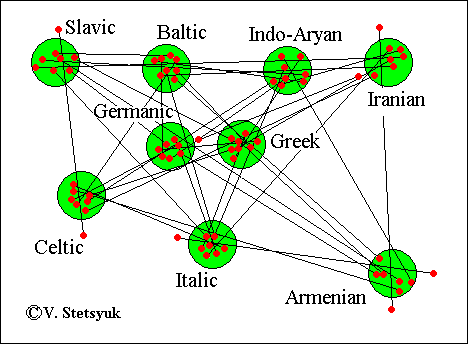 |
| Alternative Historical Linguistics |
| Settling of the Indo-Europeans, Finno-Ugrians, and Turks in Eastern Europe (Survey) |
| Left: The graphical model of the Indo-European languages relationships. |
| The getting chart is broadly corresponded with previous attempt of H. Hirt and Ler-Splawinski to give geometirical interpretation of Indo-European language kinship. When searching for a suitable place for the chart on the map, the only satisfactory possibility is to locate it in the basin of the middle and upper Dnieper and its tributaries Pripyat and Desna. The areas of the Indo-European settlements are shown on the map below. The model of the relationship and configuration of the centers of areas coincide to a sufficient degree, which is evident when comparing the figures. |
| The map of the Indo-European habitats The Areas of the Arising of the Tocharian, Albanian, Thracian, Phrygian Languages were determined separately |
| The graphical model of the Finno-Ugric language relationship. |
| The map of Finno-Ugric habitats. |
| The territory for the chart of the relationship of the Finno-Ugric languages was found clearly limited by the Volga and the Don, performing the role of the natural boundaries of water as a powerful obstacle. Areas of the formation of individual languages are also mostly limited by large rivers. The proposed location of the ancient Finno-Ugric areas can be confirmed by the data of paleobotany, in particular the spread of oak area having a common word for the name of the Finno-Ugrian languages, as well as place names. A lot of geographical names of the Finno-Ugric origin can be found on the territory occupied by the Finno-Ugrians in the For-Russian period. Most of them can be deciphered by means of several Finno-Ugric languages, but the large number of them are most likely explained exactly with those languages which outset areas correspond relevant place names. However, there are many names, such as, for example, Arzamas, which reflect the future way of migration of Finno-Ugric peoples. |
| For example:
The area of the Finnish language is limited by the river Klaz’ma on the north and the river Oka on the south. Such facts can prove the location here of the Finnish Urheimat: - the town of Likino-Dulevo is located on the swampy flat country and the both words can reflect the peculiarity of the local landscape: Fin lika “mud” and tulva „flood, owerflow“; - the village of Kochemary in Kasimov District of Riazan’ Region is good explained by Fin marja “a berry” and kataja “juniper” (cf. Mari kocho “bitter”); - the settling Tuma in Klepiki District of Riazan’ Region can have the same origin as Fin tumma “an oak”; - the town of Shatura – Fin hattara “cloud”. The area of the Komi: - Lake Vad and the village of Vad – Komi vad “a lake”; - Island Barminskiy on the Volga and the town of Barmino – Komi parma “fir forest”; - the river Sura, the right tributary of the Volga – Komi shor “a stream” (Udm shur “a river”); - the river Tiosha, the right tributary of the Oka – Komi töshchö “hollow”. More detailed about Finno-Ugric place names |
| Graphic model of Turkic language relationship. |
| Turks |
| The graphical model of the relationship of Turkic languages was built repeatedly while replenishing and correcting the table dictionary. The configuration of the newly obtained chart was not changed, but the small shift of some areas of language took place. This is due to the fact that the lexicon of particular languages is presented in the table dictionary more complete but the other is less full. This phenomenon is typical for the etymological dictionary and is explained by different study of dialect vocabulary. For this reason, the central language areas are much more compact than the peripheral. |
| The map of the Turkic habitats |